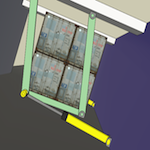 Haifeng Wang Jul 1, 2014 03:20 |
What a brilliant idea, Chris! Have you approached to ship design companies or the class for your idea? I am also wondering what's the cost benefit of the ship roll propulsion, both for new built and retrofit, and are you able to separate energy savings resulted from Ship Roll Propulsion to savings due to other factors during ship's operation?
|
 Chris Taylor Jul 1, 2014 05:21 | Proposal contributor
I’ve done surprisingly little to get this idea developed. The project was originally going to be a fleet of wave energy generators adrift 500 miles south of Iceland, producing methanol as a bunker fuel for ships travelling across the atlantic. The wave energy was to drive the ships generators to extract hydrogen from water through electrolysis. Carbon dioxide was to be scrubbed from the air by exposure to potassium hydroxide - producing potassium carbonate, and an electrochemical cell was then to recover the carbon dioxide from potassium carbonate. The Methanol would have been produced by catalytically combining hydrogen and carbon dioxide using a modified Fischer-Tropsch process. Unfortunately, the company charged with the chemical side of the project went bust, and I went off to be a musician!
It’s only because Climate CoLab came along that it made me think about using synchronous rolling to propel ships. The ideas rebirth is literally just a few days old.
|
 Climate Colab Aug 5, 2014 08:35 |
The concept is very interesting but freight hauling is probably not the best market. Marine freight hauling is dependent on reliable delivery times and huge capacities. There are many issues with the concept and the authors identified many of them. The most obvious question is “what about when the waves are small or in the wrong direction.” Wind power has similar issues where the wind doesn’t always blow strong enough or is too strong. At least a windmill can turn into the wind. This concept doesn’t have that opportunity since the ship has to travel to a set destination. The demonstration of a wave powered vessel would indeed make a very interesting project for a research institution.
|
 Chris Taylor Aug 9, 2014 12:19 | Proposal contributor
Hi Climate CoLab judges/staff,
Thanks for accepting my proposal. I do believe that vessels, having the ability to instantaneously synchronise their rolling periods to the wave periods will be a revolutionary concept, and open up possibilities not imagined before.
Let me answer your concerns. I will then incorporate these answers in my proposal, where space permits.
“Marine freight hauling is dependent on reliable delivery times and huge capacities.”
I spent 25 years navigating trade routes on the oceans. While many cargoes require tight schedules (such as electronic goods for Christmas), there is definitely a market for goods which could arrive months later than normal. For example, I’ve arrived in Amsterdam, only to discharge cocoa beans into storage barges, which would stay in storage for years. I’ve discharged steel swarf in Spain, which would lie under tarpaulins for months until processed. Colleagues of mine have been on ships instructed to slow steam around the horn of Africa, rather than take the Suez to Europe.
Like any new technology, it’s impossible to predict how markets will change, but what with the savings in marine fuel oil costs, for certain new markets will open up.
The biggest changes will come about when vessels are asked to cut their CO2 emissions. To date the authorities have been reluctant to demand this because it just hasn’t been possible. With Ship Roll Propulsion, authorities will be able to introduce tradable CO2 emissions allowances for sea trade. Vessels with zero carbon emissions will be able to create additional income streams through selling their allowances.
“What about when the waves are small or in the wrong direction. Wind power has similar issues where the wind doesn’t always blow strong enough or is too strong. At least a windmill can turn into the wind. This concept doesn’t have that opportunity since the ship has to travel to a set destination.”
In the winter North Atlantic, North Pacific and Southern Ocean, very rarely are the waves small. Even in calm weather, there is usually an ocean swell running. This is because, around every high pressure area, there are low pressure areas where the wind will whip up waves. These waves then propagate into the high pressure areas as ocean swells.
Very rarely do ships find themselves in a synchronous state with the waves, so it isn’t intuitive that the amount a vessel in a synchronous state rolls, isn’t dependent on the direction of the waves, but dependent on the approach wave period.
A vessel with a roll period of 13 seconds will roll very little in a moderate beam sea of wave period 8 seconds. However, if such a sea were to veer or back to become a following quarterly sea, the vessel would roll more heavily. This is because the waves would be chasing the vessel, and so the relative wave period would increase to nearer 13 seconds.
A vessel in a synchronous state in a moderate sea will roll heavily no matter what the direction of the sea, provided it is not from directly aft or forward. Vessels in a synchronous state with a directly head or following sea could still roll heavily due to parametric forces, though this also depends on the length of the vessel.
|
 Climate Colab Sep 3, 2014 12:27 |
It seems that the author has spent quite some time on this imaginative proposal. However, I am concerned about the complexity of the suspension system, having to carry enormous loads, and its maintenance along with the cost implications. I would also be more cautious about the potential gain of wave energy and how it translates into propulsion power--it is not clear where the numbers are coming from. While elegant on paper, it may turn out to be impracticable.
The concept is very interesting but I still believe freight hauling is probably not the best market to start with. Marine freight hauling is dependent on reliable delivery times and huge capacities. Even so, I could see a market for something that can operate for long periods with little fuel and isn't nuclear powered. For example automated drone ships for data collection would interesting, the roll-propulsion system would allow them to operate for extreme periods and long-distances. Coupled with solar power to supplement electronics and I could see this used by NOAA if the propulsion system works out. There are many issues with the concept and the authors identified and addressed many of them. The most obvious question is “what about when the waves are small or in the wrong direction. The authors did a nice job addressing the issues but there will still be times where the wave energy is low. Even so, the demonstration of a wave powered vessel would indeed make a very interesting project for a research institution.
It is not entirely clear if the calculations reflect actually the real situation in a ship. Also, in the beginning it is mentioned that suspending containers by 1mm moves the center of gravity from G1 to G - this is unclear.
Interesting proposal of a novel concept and a lot of work has gone into it.To this reviewer, the modification of existing ships does not seem to make sense but the construction of a purpose build tug/barge system might. The proposal would gain significantly if tied to a wind based kite system as well to increase the speed.The economic feasibility of the system based on existing trade (for containerized trade might be too slow but for bulk material might be easier) needs to be studied further. More importantly, the technical problems of hanging such a weight from the top structure of a tug would need to be considered (and their costs).Seems worth further investigation.
The proposal is innovative, interesting and imaginative, even if not always clear. Unfortunately, as the same authors acknowledge, a number of problems arise which limit their real effectiveness and make it economical unfeasible. Moreover, the amortization costs of the vessels seem not to be considered by the authors in their economic feasibility study which, in fact, are crucial: for shipping companies, the real problem in the slow steaming is the need of more vessels to perform the same services. On the other hand, CO2 emission represents a cost for the society and its reduction should be considered in a proper economic feasibility study. Therefore, I would encourage the authors to make a more proper economic feasibility study including these two main aspects. This would make this proposal more understandable in terms of potential impacts and comparable with other proposals also increasing the final user costs like the cap and trade actions.
|
 Chris Taylor Sep 4, 2014 10:56 | Proposal contributor
Dear Judging-Results (Staff),
Thankyou for selecting my proposal for the final round of this competition.
You have obviously given this proposal a lot of thought and raised some very interesting queries in your comments. I think it’d be best if I answer your concerns one at a time.
----------
“I am concerned about the complexity of the suspension system, having to carry enormous loads, and its maintenance along with the cost implications.”
Yes, I mentioned that I was very concerned about this challenge too, but when did great engineers start shying away from great challenges which could bring such great benefits. The energy density of ocean waves is magnitudes greater than any other source of renewable energy, including the way we harvest coastal wave energy today. we’d be mad not to tap into it.
-----------
“I would also be more cautious about the potential gain of wave energy and how it translates into propulsion power--it is not clear where the numbers are coming from. While elegant on paper, it may turn out to be impracticable.”
I clearly explain the methodology used to calculate the energy created from rolling and supplied links to spreadsheet models which can easily be checked. Even without using the spreadsheet models such calculations could easily be done on the back of an envelope. The most important factors which will require further research are due to inefficiencies, i.e. energy conversion efficiencies, and most importantly, the damping effect of the water against the vessel’s hull. Interestingly, if there were no damping effect, a vessel in a synchronous state would quickly capsize due to heavy rolling. However, the maximum energy created can never exceed the energy contained in the waves. Comparisons were made between the energy created through rolling, and the energy in the waves (IPCC figures), and at 50% efficiency for both, the amounts of energy approximately match. The whole purpose of this proposal is to suggest that MIT carry out further studies to see if my 50% efficiency estimate is accurate. Such research is beyond my mental capacity.
----------
“Even so, I could see a market for something that can operate for long periods with little fuel and isn't nuclear powered. For example automated drone ships for data collection would interesting, the roll-propulsion system would allow them to operate for extreme periods and long-distances. Coupled with solar power to supplement electronics and I could see this used by NOAA if the propulsion system works out.”
That’s a brilliant idea. The sun often shines when the sea is calm. At the other extreme, fuel consumption rapidly increases for ships in adverse weather, but adverse weather would suit wave propelled vessels perfectly.
----------
“in the beginning it is mentioned that suspending containers by 1mm moves the center of gravity from G1 to G - this is unclear.”
For any cargo officer serving on a heavy lift vessel equipped with its own lifting gear , this is both common and essential knowledge. Before a heavy lift operation takes place, the cargo officer carefully calculates the stability of the vessel at the point in the operation when the vessel will be least stabil. This point happens the moment the heavy cargo is lifted from the quay or the vessels deck. The vertical position the weight of the heavy cargo acts is immediately transferred to the derrick head, and is not dependent on the length of the cargo runner (cable attaching the derrick head to the cargo). This results in a large and sudden vertical shift in the center of gravity which could make a vessel dangerously unstable. (See page 19) http://www.maritimenz.govt.nz/Publications-and-forms/Commercial-operations/Shipping-safety/Vessel-Stability-Guidelines-A4.pdf
----------
“Moreover, the amortization costs of the vessels seem not to be considered by the authors in their economic feasibility study which, in fact, are crucial:”
I’m definitely no expert in Marine Transport Economics, but I got around the need to calculate amortization costs by doing the calculations from a charterers point of view. By chartering a vessel at todays prices, the amortization costs would already have been taken into account. I did make an assumption that the wave propulsion system would not be more expensive than a vessel's main engine, so that chartering costs would be about the same. However, the cost of constructing such a propulsion system can not be truly estimated until it is designed in detail.
----------
“for shipping companies, the real problem in the slow steaming is the need of more vessels to perform the same services”
This has been taken into account. The proposal estimated that a vessel would take three times as long to reach it’s destination, meaning that chartering costs would be tripled, and overall costs to the charterer would be doubled.
As per examples given in the proposal:
The cost of chartering a 350 TEU vessel is about 4000 USD per day. Fuel consumption (at 12 tonnes per day) would be 7000 USD per day, so the total would be 11000 USD per day. A 15 day voyage would cost 165000 USD.
The cost of chartering a 2.2MW wave energy tug would be about 4000 USD per day. A 350 TEU barge would be about 3000 USD per day. So the total is 7000 USD per day. A 45 day voyage would cost 315000 USD.
The wave energy tug and tow would be nearly twice as expensive per voyage.
-----------
“On the other hand, CO2 emission represents a cost for the society and its reduction should be considered”
In other words, what should the price on carbon be before the wave energy tug and tow become competitive with the fuel driven vessel.
In the above examples, the fuel powered vessel costs 150000 USD less per voyage. Thats 10000 USD cheaper per day (for a 15 day voyage), and 830 USD cheaper for each tonne of IFO consumed (at a consumption of 12 tonnes per day). That’s 280 USD cheaper for each tonne of CO2 emitted (3000 kg CO2 / tonne IFO). (See page 21: http://www.imo.org/blast/blastDataHelper.asp?data_id=26402&filename=INF-6.pdf)
In other words, the price on CO2 should be 280 USD / tonne before the wave energy tug and tow become competitive with the fuel driven vessel. If the price on CO2 started at $10 / tonne and increase at $10 / tonne per year, we would have to wait until mid century before the price on CO2 reached $280 / tonne.
In reality, the break-even point would be considerably before mid century, because the price of IFO will probably rise even without a price on carbon, as crude extraction costs become more expensive.
|
 Hemant Wagh Sep 6, 2014 02:27 |
If the walking platforms could be used to generate electricity would it not be possible to use the waves pushing the ship backwards for generating the electricity to be used on the ship! This may reduce the consumption of fossil fuel needed for this purpose. Would you like to consider such a mechanism along with the Sync one!
|
 Chris Taylor Sep 7, 2014 10:46 | Proposal contributor
Hi Waghhm,
These futuristic cloud seeding ships generate energy in a similar way to what you have suggested:
http://news.bbc.co.uk/2/hi/programmes/6354759.stm
|
 Osero Shadrack Tengeya Sep 17, 2014 03:51 |
Hi Christa and your friends, kindly consider voting for my proposal shown on this link.
https://www.climatecolab.org/web/guest/plans/-/plans/contestId/1300206/planId/1002
Thanks.
|
 Anne-marie Soulsby Sep 23, 2014 03:03 |
Hi Chris,
Please consider voting for my proposal, https://www.climatecolab.org/web/guest/plans/-/plans/contestId/1300801/planId/1309001
Good luck with your entry!
Asante/Thank-you
@conserveaction
|
